Despite being an old language, PHP still comprises 79.8% of all web applications that nearly translates to 20 million websites and 2 million web servers. According to zdnet.com, the demand for PHP developers has also massively increased to 834% since January 2020.
What Is PHP?

PHP stands for Hypertext Preprocessor. It is an open-source server-side scripting language used for dynamic web development and can be embedded into HTML codes.
Syntax: PHP Script
A PHP script is usually embedded into another language, such as HTML codes since a browser does not understand PHP.
The syntax for the script is:
|
<?php //Write Script here > |
Now that you have a clear understanding of ‘What is PHP’ and its Syntax, it’s time to understand why one should learn PHP.
Why Should You Learn PHP?
Some of the major benefits of using PHP are:
- It is an open-source language. This means that PHP is freely available to use and implement.
- It is an easy-to-learn language. Since it is very similar to how HTML codes are written, it is easy to understand and implement.
- It is highly compatible since it can be integrated with multiple programming languages such as HTML, Javascript and supports different databases like MySQL, PostgreSQL, Oracle, etc.
- It is platform-independent, which means that applications developed using PHP can run in any environment.
- It has a large community of developers. Programming is all about helping and being helped; hence a large community would mean more help.
- It is regularly updated and hence works well with the latest technologies.
Moving further, let's look at the differences between PHP and other server-side scripting languages.
PHP vs. Other Server-Side Scripting Languages
Below are some primary differences among PHP, ruby on rails and node.js
Characteristics |
PHP |
Ruby on Rails |
Node.js |
|
Open-source |
Yes |
Yes |
Yes |
|
Market Share |
79.8% |
2.4% |
0.6% |
|
Flexibility |
Highly Flexible |
Low Flexibility |
Flexible |
|
Scalability |
Low |
Low |
Easily Scalable |
|
Learning Curve |
Very Easy |
Hard |
Easy |
|
Stability |
Very Stable |
Stable |
Still Immature |
|
Websites |
Facebook, Yahoo, WordPress, etc |
Github, Yellow Pages, Airbnb |
Uber, LinkedIn, Netflix, etc |
By now, you know what PHP is, and why it is necessary. Let’s now look at how a PHP page functions.
How Does PHP Work?
PHP being a server-side language, the entire workflow is on the server itself. A PHP interpreter is also installed into the server to check for PHP files. While on the client-side, the only requirement is a web browser and internet connection.
Let us understand step-by-step how a PHP page works:
Step 1: The client requests the webpage on the browser.
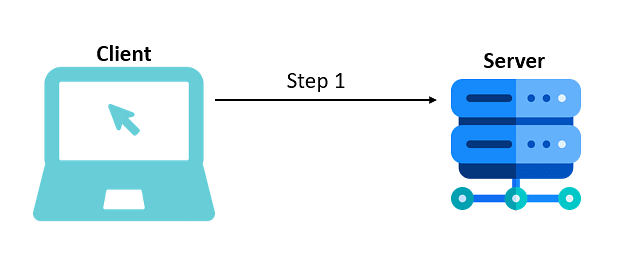
Step 2: The server (where PHP software is installed) then checks for the .php file associated with the request.

Step 3: If found, it sends the file to the PHP interpreter (since PHP is an interpreted language), which checks for requested data into the database.
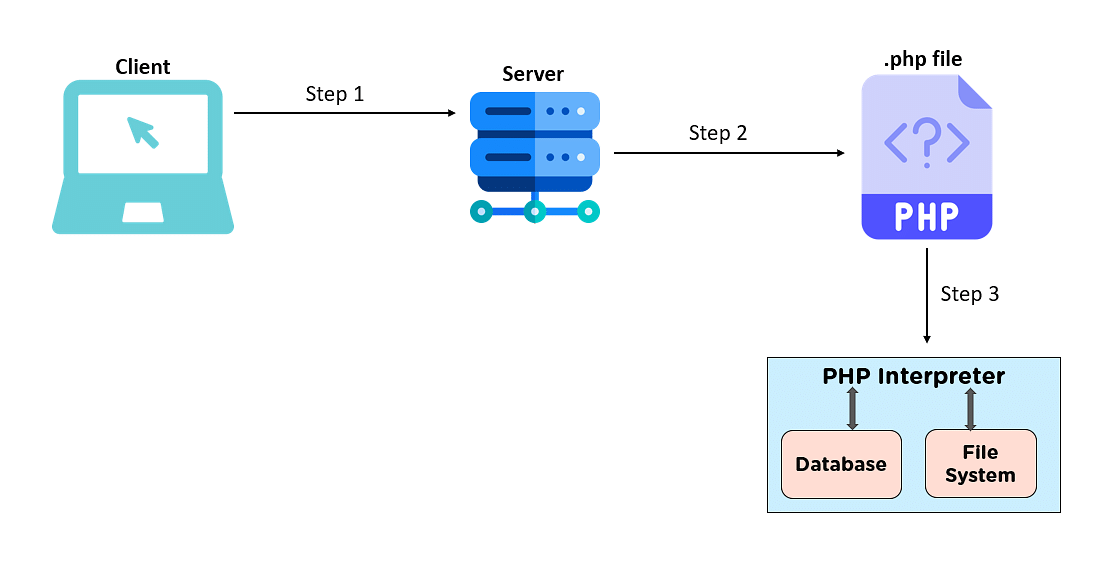
Step 4: The interpreter then sends back the requested data output as an HTML webpage (since a browser does not understand .php files).
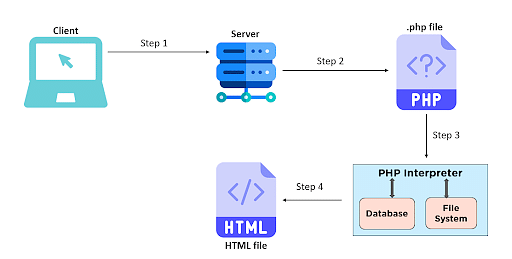
Step 5: The web server receives the HTML file from the interpreter.
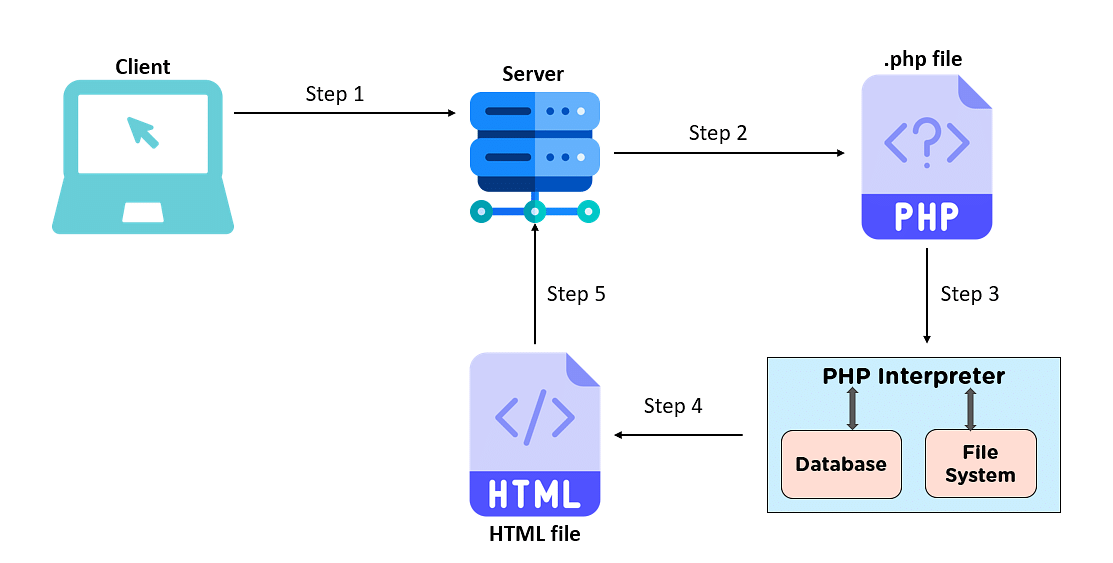
Step 6: And it sends the webpage back to the browser.
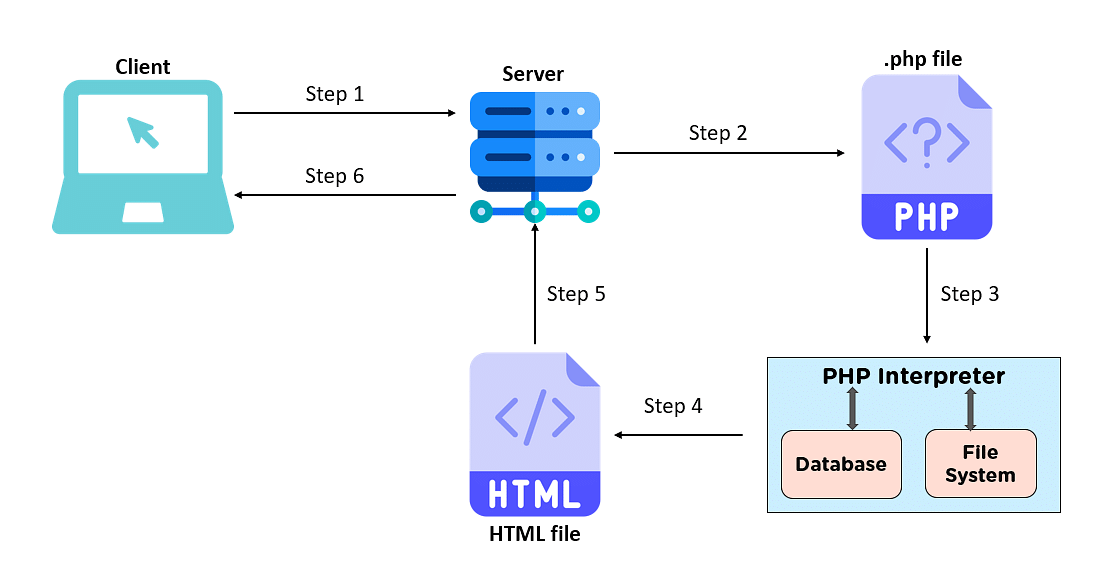
Demo - Hello World Program
What Do you Need?
First, you need to set up the PHP environment. To do that:
- Install XAMPP software to host your local webserver
- Next, install any code editor of your choice. eg; Visual Studio Code, Notepad++, etc.
Now, before we start writing our first code:
- Go to C:\xampp\htdocs\ and create a folder. Name it “demo”. You can choose to name anything suiting your project
- Open XAMPP control panel and start the Apache server
- Now open Visual Studio Code and open the same folder and create a file named ‘index.php’
Start writing your first code now:
|
<!DOCTYPE html> |
Output:

To view the output, open your web browser and type ‘localhost/’ followed by the folder name you have created in htdocs.
In this case, it is ‘localhost/demo/’.
Now, you have the output for the first PHP program.
Project Ideas:
Now, if you’re wondering what kind of projects, you can create with the help of PHP, this article has some project ideas from beginner to advanced.
Beginner:
- Unit Converter
- Simple quiz application
Intermediate:
- Chatbot for your University website
- Blood bank registration and management
Advanced:
- Entire E-commerce website
- A social media platform
Conclusion:
This brings you to the conclusion of the ‘What Is PHP’ article. You have learned What PHP is, its syntax, and the need for it. Later, you saw how a PHP page works, and in the end, there was a demo for your first PHP program.
For a detailed tutorial on setting up the PHP environment and creating a hello world program, you can refer to this Tutorial.
Don’t stop at just the fundamentals. Look to master the php language and give yourself a golden chance to get into top companies. Simplilearn’s Post Graduate Program In Full Stack Web Development is the ideal next step for you. From learning 20 of today’s most in-demand software development skills to perfecting them with real, industry-aligned projects, you will find this full stack development bootcamp to be everything you need to become a world-class full stack web developer today.
Do you have any questions for us? Please mention it in the comment section of the "What is PHP?" article, and we'll have our experts answer it for you.
Happy learning!
